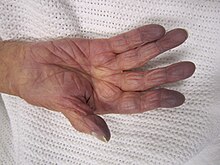User:Mr. Ibrahem/Hypoxia (medical)
| Hypoxia | |
|---|---|
| Other names | Anoxia, hypoxiation, oxygen desaturation, lack of oxygen, low blood oxygen, oxygen starvation |
 | |
| Cyanosis of the hand in an elderly person with low oxygen saturation | |
| Specialty | Pulmonology, toxicology |
| Symptoms | Shortness of breath, confusion, headache, bluish skin[1] |
| Types | Hypoxemia, ischemia[1][2] |
| Causes | Hypoxemia: Pneumonia, asthma, COPD, pulmonary edema, foreign body aspiration, opioid overdose, pulmonary embolism, congenital heart defects, high altitude, carbon monoxide toxicity, interstitial lung disease[1] Ischemia: Arterial blood clot, vasospasm, peripheral artery disease[2] Other: Anemia, cardiogenic shock, cyanide poisoning[1] |
| Diagnostic method | Pulse oximetry[1] |
| Treatment | Airway management, oxygen therapy, improving lung function[1] |
| Frequency | Common[1] |
Hypoxia is a condition in which body tissues are deprived of adequate oxygen.[3] When onset is sudden, symptom may include shortness of breath and fast heart rate.[1] When moderate in severity, confusion and headache may occur, while in severe disease the skin may become bluish and the person may become unresponsive.[1] When more gradual in onset, the initial symptom is often shortness of breath with exercise.[1]
There are two main causes of hypoxia: low oxygen content in the blood (hypoxemia) and insufficient blood flow to tissue (ischemia).[1] Hypoxemia can occurs due to pneumonia, asthma, COPD, pulmonary edema, foreign body aspiration, opioid overdose, pulmonary embolism, congenital heart defects, high altitude, carbon monoxide toxicity, and interstitial lung disease.[1] Ischemia can occur due to an arterial blood clot, vasospasm, or peripheral artery disease.[2] Hypoxia may also occur due to anemia, cardiogenic shock, and cyanide poisoning.[1] Diagnosis is most commonly by pulse oximetry finding saturations of less than 90 to 95%.[1][4]
Management may involve airway management, increasing the amount of oxygen being breathed, and improving the uptake of oxygen by the lungs.[1] This may be achieved with measures that vary from the use of nasal cannula to endotracheal intubation.[1] Hypoxia is common.[1]
References[edit]
- ^ a b c d e f g h i j k l m n o p q Bhutta, BS; Alghoula, F; Berim, I (January 2020). "Anoxia". PMID 29493941.
{{cite journal}}: Cite journal requires|journal=(help) - ^ a b c "Ischemia and Hypoxia". www.cvphysiology.com. Archived from the original on 27 November 2020. Retrieved 22 February 2021.
- ^ "Definition of HYPOXIC". www.merriam-webster.com. Archived from the original on 9 July 2021. Retrieved 22 February 2021.
- ^ "Oxygen Desaturation - Critical Care Medicine". Merck Manuals Professional Edition. Archived from the original on 22 January 2021. Retrieved 22 February 2021.
